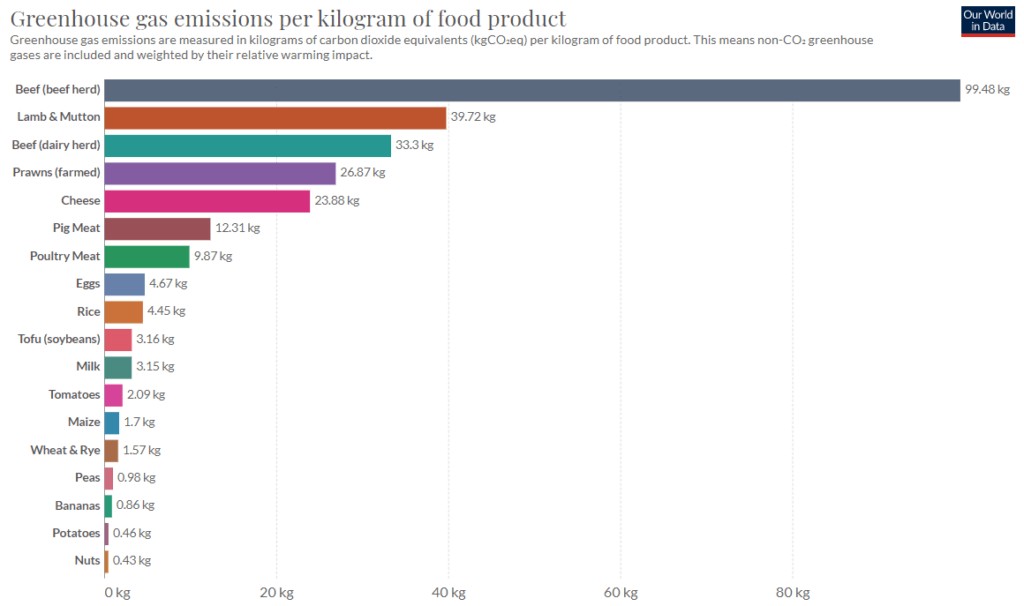Comparing the protein content between chickpeas and chicken can be confusing. At COMPARE.EDU.VN, we provide a clear breakdown of their nutritional profiles, amino acid composition, and environmental impacts to help you make an informed decision. Understand the protein comparison, nutritional value, and environmental factors related to chickpeas and chicken.
1. Do Chickpeas Or Chicken Have More Protein?
Chicken contains significantly more protein than chickpeas. It’s a common misconception that plant-based proteins can easily match animal proteins in quantity.
- In 100 grams of chicken (approximately 239 calories), there are about 27 grams of protein.
- In 1 cup of cooked chickpeas (approximately 269 calories), there are about 14.5 grams of protein.
Therefore, chicken provides roughly twice as much protein per calorie compared to chickpeas.
To provide a clearer comparison, here’s a table summarizing the macronutrient content:
| Chickpeas (100g) | Chicken (100g) | |
|---|---|---|
| Serving Size | 100g | 100g |
| Calories | 164 | 239 |
| Fat | 2.6 g | 14 g |
| Carbohydrates | 27.4 g | 0 g |
| Fiber | 7.6 g | 0 g |
| Protein | 8.9 g | 27 g |


As the table shows, chicken is low in carbohydrates but high in protein and fat. Chickpeas are higher in carbohydrates and fiber while being lower in calories.
Summary
While the specific cut of chicken affects its macronutrient profile, chicken typically contains more protein and fat than chickpeas. Chickpeas, on the other hand, are richer in carbohydrates and fiber and have fewer calories overall.
2. Amino Acid Profile Comparison: Chickpeas Vs. Chicken
While obtaining all essential amino acids from a single food source is convenient, it’s not necessary as long as you consume a variety of foods throughout the day. However, knowing the amino acid profiles of chickpeas and chicken helps in understanding their nutritional contributions.
Here’s a side-by-side comparison of the amino acid content in chickpeas and chicken breast, along with the Recommended Daily Allowance (RDA) for each:
| RDA (mg per kg) | RDA (for 70 kg person) | Chickpeas (1 cup) | Chicken Breast (300 grams) | |
|---|---|---|---|---|
| Calories | 269 | 237 | ||
| Tryptophan (mg) | 4 | 280 | 139 | 549 |
| Threonine (mg) | 15 | 1050 | 540 | 2,058 |
| Isoleucine (mg) | 20 | 1400 | 623 | 2,436 |
| Leucine (mg) | 39 | 2730 | 1035 | 3,603 |
| Lysine (mg) | 30 | 2100 | 973 | 4,005 |
| Methionine (mg) | 15 | 1050 | 190 | 1,311 |
| Phenylalanine (mg) | 25 | 1750 | 779 | 1,935 |
| Valine (mg) | 26 | 1820 | 610 | 2,418 |
| Histidine (mg) | 10 | 700 | 400 | 1,434 |
Chickpeas offer a decent amino acid profile. Consuming two to three servings can help you meet your RDA for most amino acids, except methionine. Chicken, however, meets all essential amino acid RDAs within a 300-calorie serving, making it a more efficient source.
Summary
Chicken surpasses the RDA of all essential amino acids in a relatively small serving. Chickpeas, while having a reasonable amino acid profile, require a larger serving to meet the RDA of most amino acids, particularly methionine.
3. Nutritional Value Comparison: Chickpeas Vs. Chicken
While chicken is a protein-rich choice, the nutritional landscape shifts when vitamins and minerals are considered.
Here’s a comparison of the percent Daily Value (%DV) of various nutrients in chickpeas and chicken:
| Chickpeas (%DV) | Chicken (%DV) | |
|---|---|---|
| Fiber | 50% | 0% |
| Niacin | 4% | 51% |
| Vitamin B6 | 11% | 24% |
| Folate | 71% | 0% |
| Iron | 26% | 6% |
| Magnesium | 20% | 6% |
| Phosphorus | 28% | 18% |
| Potassium | 14% | 6% |
| Zinc | 17% | 6% |
| Copper | 29% | 6% |
| Manganese | 87% | 6% |
| Selenium | 9% | 33% |
Chickpeas excel in most categories, particularly in essential nutrients like iron, zinc, magnesium, and potassium. Chicken provides more niacin, vitamin B6, and selenium, though these nutrients are readily available from other sources.
Summary
Chicken is not particularly rich in vitamins and minerals, while legumes like chickpeas are packed with several key nutrients, including iron, magnesium, and potassium.
4. Environmental Impact of Chicken and Chickpeas
The environmental impact of food choices is increasingly important. Plant-based proteins generally have a lower environmental footprint compared to animal-based proteins, considering factors like emissions and land use.
Chicken farming emits about 9.87 kilograms of carbon dioxide equivalents per kilogram of meat. While specific data for chickpeas may vary, other legumes like soybeans (3.16 kg) and peas (0.98 kg) demonstrate significantly lower emissions.
Therefore, cultivating chickpeas generates far fewer emissions compared to chicken production.
In terms of land use, the figures are relatively close. Poultry meat requires about 7.1 square meters per 100 grams of protein, while other pulses (including chickpeas) require approximately 7.3 square meters.
Summary
While chicken is among the more environmentally friendly meat options, legumes like chickpeas have a significantly lower environmental impact, mainly due to reduced emissions during cultivation.
5. Key Differences Between Chicken and Chickpeas
For those following a vegan diet, chickpeas and other legumes are reliable protein sources that offer substantial nutritional value.
In a mixed diet, chickpeas are superior in vitamins and minerals, while chicken provides a higher protein content. Alternatives like Seitan vs chicken may offer closer protein levels.
Ideally, a balanced diet includes both chicken and chickpeas to harness their distinct benefits, depending on individual dietary needs.
For those concerned about environmental impact, prioritize chickpeas and other plant-based proteins over meat alternatives.
6. Are Chickpeas Healthier Than Chicken?
In most contexts, chickpeas are considered healthier than chicken due to their broader nutritional profile.
However, no single food defines overall health; it depends on the entire diet. Chicken may be a healthier choice for individuals lacking protein or niacin.
In most cases, chickpeas offer a healthier option due to their fiber content and an array of vitamins and minerals, which are often deficient in standard diets.
7. Five Search Intentions Related to “How Much Protein in Chickpeas Compared to Chicken”
- Nutritional Comparison: Users want to compare the protein content and other nutritional aspects of chickpeas and chicken to make informed dietary choices.
- Health Benefits: Individuals seek to understand which food is healthier overall, considering protein content, vitamins, minerals, and other health benefits.
- Dietary Planning: People planning meals or specific diets (e.g., vegan, high-protein) want to know how these foods fit into their nutritional goals.
- Environmental Impact: Environmentally conscious consumers compare the ecological footprints of chickpea and chicken production.
- Amino Acid Profile: Athletes and fitness enthusiasts are interested in the amino acid composition of both foods to optimize muscle building and recovery.
8. Frequently Asked Questions (FAQ)
8.1. Is chicken a complete protein?
Yes, chicken is a complete protein, meaning it contains all nine essential amino acids in sufficient amounts. These amino acids are crucial for various bodily functions and cannot be produced by the body itself.
8.2. Are chickpeas a good source of protein for vegetarians?
Chickpeas are an excellent source of protein for vegetarians and vegans. While they don’t contain as much protein as chicken per serving, they offer a substantial amount of protein and other essential nutrients.
8.3. How do chickpeas compare to other legumes in terms of protein content?
Chickpeas are comparable to other legumes like lentils and black beans in terms of protein content. They generally offer a similar amount of protein per serving, making them a versatile option for plant-based diets.
8.4. Can I get enough protein from chickpeas alone?
While chickpeas are a good source of protein, relying solely on them may not provide all the protein and essential amino acids you need. It’s best to include a variety of plant-based protein sources in your diet to ensure a balanced intake.
8.5. What are the best ways to prepare chickpeas to maximize their nutritional value?
Soaking and cooking chickpeas thoroughly can enhance their digestibility and nutrient absorption. Roasting, boiling, or adding them to soups and stews are great ways to incorporate them into your diet.
8.6. What are the health benefits of eating chicken?
Chicken is a lean source of protein and provides essential nutrients like niacin, vitamin B6, and selenium. It supports muscle growth, immune function, and overall health.
8.7. Are there any risks associated with eating too much chicken?
Eating excessive amounts of chicken, especially fried or processed varieties, can lead to increased cholesterol levels and a higher risk of heart disease. It’s important to balance your diet and choose lean preparation methods.
8.8. How does the protein in chickpeas affect muscle growth compared to chicken?
The protein in both chickpeas and chicken can support muscle growth, but chicken’s higher protein content per serving makes it a more efficient option. Chickpeas can still contribute to muscle growth as part of a balanced diet.
8.9. Is organic chicken more nutritious than conventional chicken?
Organic chicken may have some advantages in terms of reduced exposure to antibiotics and hormones. However, the nutritional content is generally similar to conventional chicken.
8.10. How do I balance my diet if I choose chickpeas over chicken for environmental reasons?
If you opt for chickpeas over chicken for environmental reasons, ensure you consume a variety of other nutrient-rich foods to meet your protein and micronutrient needs. Combining chickpeas with grains, vegetables, and other legumes can create a balanced and nutritious diet.
At COMPARE.EDU.VN, we understand the challenges in comparing various options. That’s why we offer comprehensive and objective comparisons to help you make informed decisions. Whether you’re weighing the protein content of chickpeas versus chicken or evaluating the environmental impact of different foods, our resources are designed to provide clarity and empower your choices.
Need more comparisons to guide your decisions? Visit COMPARE.EDU.VN today and explore a wealth of detailed comparisons to help you make the best choices for your needs.
Contact Us:
- Address: 333 Comparison Plaza, Choice City, CA 90210, United States
- WhatsApp: +1 (626) 555-9090
- Website: compare.edu.vn
